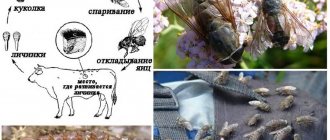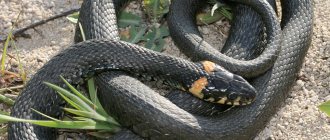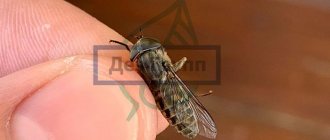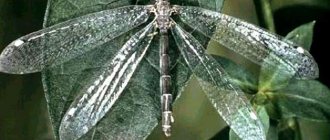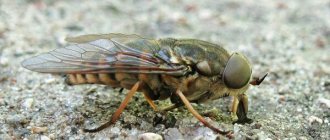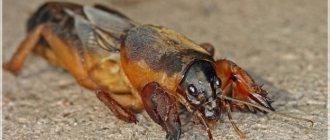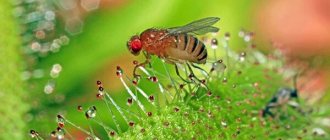Among over 150 species of gadflies, only one is dangerous to humans, called Dermatobia Hominis. It cannot be found in Russia and the CIS countries - the insect is found only in countries with a tropical climate: Central America, Argentina and some areas of Mexico. A gadfly larva in a person can cause a lot of unpleasant phenomena: inflammation, suppuration, disruption of the normal functioning of body systems, and surgical intervention may be required to remove it.
What do a gadfly and its larvae look like?
Gadflies live in almost every corner of the planet; in total there are more than 150 species of insects. In our country, 60 varieties are registered. Usually, gadflies lay their larvae in the body of animals, less often they get under the skin of a person. Dermatobia Hominis - the “human gadfly” lives in the tropics (Mexico, South America, Argentina). In the temperate climate of Russia, Ukraine and the countries of the former USSR, the insect has not been observed.
The adult is a special species of fly measuring up to 20 mm. Dermatobia Hominis looks like a small bumblebee: a shaggy body and a bright orange color. The gadfly has a rather large head with pronounced large eyes, a blue abdomen, and small transparent wings.
Insects living in our latitudes usually have a calmer color: dark brown or coal-black, gray-blue. They prefer livestock as a host, but it happens that when they bite, they also infect humans.
The adult does not feed; the supply of nutrients obtained during the larval development stage is enough for the entire life cycle.
The larva after birth is very small. During the phase, it grows several times, reaching 2 cm. Its body has an oblong teardrop shape. Special hook hairs allow it to attach to the skin of animals or humans.
One adult female can reproduce up to 650 eggs, but only 20% are viable.
A species of dangerous gadfly that lives in southern countries.
How does a gadfly larva enter the human body?
The gadfly larva can enter the human body in several ways:
- The female lays eggs on the abdomen of blood-sucking insects (mosquitoes, ticks). When a person is bitten by intermediary insects, the eggs land on the person's body. When warmed up, they burst and larvae emerge from them, which get under the skin. The introduction of parasites is practically not noticeable.
- When a human is bitten directly by the female gadfly itself, the larvae enter the wound, after which they fully develop as parasites in the person.
- Hypodermatosis is a disease associated with these parasites. In this case, the larva is acquired tactilely from cattle. It is the countryside and farms in our latitudes that can be considered a potential site of infection. Parasites get under the skin, and they can move along the body, leaving characteristic traces. The larvae usually penetrate the body in areas where the skin is more delicate, for example, on the head, arms and legs, abdomen, neck, and less often they can concentrate on the lips and in the eye.
- Eggs and larvae can also enter internal organs. This occurs when eating animal meat contaminated with gadfly. The gastric parasite is much more dangerous than the subcutaneous larva of the gadfly, since its parasitism can lead to serious disruptions in the functioning of the body.
More complex forms may also occur, when there are several larvae in different areas of the human body.
Procedure after a gadfly bite
Direct treatment of a gadfly bite is preceded by first aid. Without it, the consequences are much stronger, and their elimination is longer and more labor-intensive.
First aid
- Pressing down.
Immediately after the gadfly bites, press down on its place with any hard object at hand or pinch the skin with a pinching movement of your fingers. This will prevent the rapid spread of allergic contents and reduce pain.
- Cold.
Cold water, any metal object, ice and other cool surfaces will do. The purpose of this effect is similar to pressing - to reduce swelling from a gadfly bite, pain, and itching.
- Soap.
If you have it on hand, it is good to apply a soap compress to the bitten area. Any toilet or laundry soap is suitable for this. Lather it on a damp cloth and apply it to the bitten area. If it is not available, you can generously soap the area where the gadfly has bitten.
- Antiseptic.
How to anoint a gadfly bite? We recommend that you avoid products with a burning and very drying effect. It is best to use a solution of Rivanol 0.1%. Its bottle will not take up much space in your medicine cabinet or purse and will be useful in a variety of situations. Simply wipe the bitten area with a cotton swab or cloth soaked in it.
Carefully! The yellow solution of Rivanol leaves marks on fabric and skin. But this is its only drawback.
IMPORTANT: “Consultation with a physician is required before use”
Gadfly bites usually occur unexpectedly, and most often you have to use improvised means. As first aid in the absence of other means, the juice of a crushed plantain leaf or dandelion stem, chopped onions, a salt or soda solution, and vodka lotions will help. But, these are only first aid measures if it is impossible to use Rivanol.
The above recommendations will help you avoid the rapid growth of swelling from a gadfly bite, prevent secondary infection, and relieve itching and pain. If swelling and/or redness grows beyond 7 cm in diameter, you should definitely consult a doctor.
Stages of larval development
The larval stage of the gadfly usually lasts 6-10 weeks. After entering the host’s body, the parasite begins to intensively feed on blood, drawing out useful substances. In a few weeks it increases in size tens of times, and the mature larva reaches 2 cm.
The photo shows a small gadfly larva extracted from a human body.
Having collected the necessary supply of nutrients from the host, the parasite breaks through the skin and crawls out. After this, a new stage of development of the gadfly begins - the pupa. In this phase, the insect arrives for 2-4 weeks, after which it turns into an adult, the life cycle of which is 20 days, the main task of the fly is reproduction.
Establishing a diagnosis
If a person suspects he is infected, he should seek help from a good parasitologist or infectious disease specialist.
The doctor sends the patient for a blood test, which determines the amount of antibodies. The specialist undertakes to find out from his client whether he has been to African countries or other places where the terrible gadfly lives.
A visual inspection is required. If infection occurs, an abscess with a fairly large hole forms on the cover.
Inspection is carried out using a special magnifying glass.
Symptoms of the appearance of gadfly larvae in humans
Parasites penetrate into any part of the body, their penetration at the initial stage is not noticeable at all. After 1-2 weeks, the site of penetration swells, turns red, and looks like a mosquito bite.
After another couple of weeks, the skin becomes blue, swelling appears with suppuration in the center, like the stem of an acne. The abscess bursts and the open wound allows the parasite to gain access to air.
The general health of a person infected with gadfly larvae worsens: nausea and dizziness, weakness, fever, and burning in the affected area appear.
If the larva is in the eye, tearing, redness, increased eye pressure, and less often bleeding are observed.
Less commonly, a focus of development is observed in the nasal cavity, as evidenced by pain, headaches, and swelling.
How dangerous are these flies for people?
The human skin botfly, which lives in hot countries, is the cause of the formation of myiases on the body.
Depending on the location of the lesion, there are:
- cutaneous - formed mainly when eggs are laid on the hair;
- genitourinary - from contact with contaminated underwear;
- intestinal - from eating a product infected with botfly eggs;
- nasal;
- ear;
- ophthalmic
The danger comes from myiases located on the head in close proximity to the brain. In practice, there have already been cases of death due to the introduction of larvae into this organ. In mild cases, damage to the eyeball causes conjunctivitis. In more severe cases, it leads to loss of the ability to see.
Infection with larvae belonging to the gadfly family can occur not directly from a female planting an egg on a hair, but also indirectly through food or clothing that she has also visited.
The most common is dermatobiasis, when the larva settles under the skin. Externally, there is a large abscess with a duct secreting pus. The most favorable areas are the upper back, armpits, stomach, legs, arms and head.
What harm do gadfly larvae cause to humans?
Undoubtedly, gadfly larvae cause serious harm to the human body. The degree of impact directly depends on the location of the parasites. Skin larvae disrupt the general state of health, the functioning of organs, and poison the body with waste products.
The most dangerous are cavity parasites that concentrate in the internal organs: stomach, intestines, ENT organs.
Complete blindness is threatened by the larva of the gadfly, deposited in the human eye.
It is very important to eliminate the pest at an early stage of development to minimize complications.
How to remove a botfly larva from under the skin?
Removal of the larva can be carried out in two ways:
- surgical;
- medicinal.
The main task of any method is the safe removal of the foreign body. The removal operation is performed under sterile conditions. The affected area is treated with an antiseptic (iodine, potassium permanganate). A drop of sterile oil will help block air access to the larva. Once in unfavorable conditions, it will begin to crawl out of the body on its own. The parasite is pulled out using tweezers or a special clamp.
The larva crawls out from under the skin in the leg.
After removal, the wound is treated and then bandaged with a sterile cloth.
The operation must be carried out by a specialist, since if you extract it yourself, parts of the parasite may remain under the skin, which will cause inflammation and suppuration of the wound.
The safest extraction is to allow the larva to leave the host’s body on its own. To do this, use ointments, creams and oils to remove parasites.
Extracted larva and skin damage.
A course of drug treatment will allow you to provoke the release of a foreign object, affecting it through its source of nutrition - blood. Such drugs contain substances that are toxic to the parasitic organism.
Prevention of infection
To avoid infection by larvae, caution is required when traveling, particularly to tropical countries. It is recommended to adhere to the following rules:
- wear clothes that cover the body as much as possible;
- use repellents;
- when the bite has already occurred, it needs to be treated with an antiseptic;
- If you feel unwell, you should consult a doctor.
Numerous larvae can provoke a variety of consequences, for example:
- allergies;
- purulent infection;
- meningitis, pneumocephalus, ulcer;
- erosion of the nose or eyes.
Important! Having seen redness of the skin, which looks like a bite, you need to determine whether it is affected by a gadfly, in particular, while staying in tropical countries. One of the effective methods of counteracting dermatobiasis is the destruction of flies, mosquitoes and other insects in the house.
